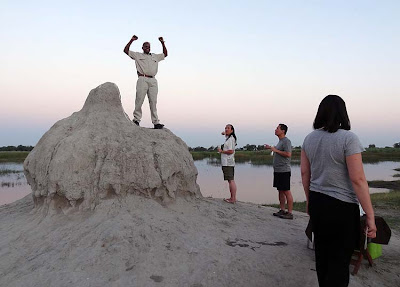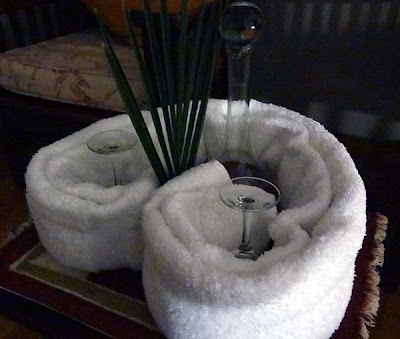

While still fairly close to camp we arrived in a clearing with a large marula tree and could see the orange and black spots of an adult leopard.

Other trucks had already gathered and all eyes looked upwards. Even without binoculars we could see where the leopard's strong jaw had carried the dead impala high into the tree and was resting his head on its prize.

Coca said the kill happened several hours before we got there. The impala was an adult female with wounds to her face and was bleeding from the neck. Blood had collected at the end of her nose.

We weren't able to tell whether the leopard had eaten any of his kill yet, however, Coca said a full size impala was enough food for two days and the cat would not have to kill again for about one week. From this angle, we determined the cat was male.

Within ten yards of the tree trunk was a lioness and her six-month old male cub waiting to steal the impala.

Up in the tree the leopard looked as if he were sleeping and occasionally he peered down with an awareness of the mother and cub who wanted the fruit of his labor. The leopard rested, so Coca suggested we go off for a while and return later.

When we came back the leopard was cleaning himself. He was lapping at his paws to wipe away impala blood after his meal. With binoculars we could see a scar on his nose.

The lioness left her cub and walked to the base of the tree. We watched her assess the tree, but lions don't climb as high as leopards. The leopard stood up from his perch and climbed down, almost to the ground. This made us excited because a showdown was about to happen.


Instead, the leopard went back into the treetop and the lioness went to sniff impala blood where it pooled below. To our surprise, we all heard a large crack after the dead impala slipped and broke through a large branch. It landed at the base of the tree and the lioness made off with the leopard's meal -- poor thing! We thought the lioness would share with her cub, but instead we heard snarling and fighting over the impala.
This event was the highlight of our safari. When usual sightings were from a great distance or very brief, we watched this play out for over an hour and in close proximity. See the short version of what we saw here:

* * * * * * * *

This is the track of a puff adder snake moving across the walkway to our tent. The snake followed the direction of a hippo path that intersected our tent's walkway.

Camp breakfast at Moremi: Fruit, sweet melons, ham, eggs cooked to order, and homemade bread. At all our meals no one ever went hungry and we often went back for seconds. There was always plenty of delicious food for everyone.

A beautiful impala buck staring us down -- what a handsome crown of horns!

Elephants rub against trees, causing the bark to fall off. Worms eat the inner soft layers. Woodpeckers eat the worms. All these cause trees to die.

There is more to Coca, our guide, than meets his quiet presence and his clever humor took us by surprise. Initially, Coca probably thought our family wasn't paying enough attention to the safari, "How many eyes do we have in the truck? More eyes have more possibilities to see animals!" Before our trip, Tien read that a guide named Coca at Camp Moremi saved a man from serious injury or death by an alligator. When we asked Coca about the incident, he was a bit embarrassed, but gave us all the exciting details. Read about it here.

Coca identified the red lechwe's dung chunk in his hand and an impala's pellet-like poop on the ground. You know me (and Serene too), "Oh, euww, Coca, you're touching it!!" and then I quickly gave him an antibacterial wipe, hahaha.

Beautiful dead trees in the Okavango Delta

Our last brunch at Camp Moremi before departing

Tien, me, our Camp Moremi guide Coca, Serene, Kuan.

Sweeping view of Camp Moremi on my left, across the Xakanaxa Lagoon, and right onto Moremi's viewing platform. What a beautiful place! Tien and I were sad to say goodbye to Setch (manager), and to BK esp because we spent a lot of time with him and greatly enjoyed his company.

Coca relaxed and laughed with us while we waited for our chartered plane to the next camp. He's knowledgeable and has a great sense for the animals. Thank you, Coca! Our trip was made better because of your expertise.

This was the smallest plane of all our charters. I climbed into the back, and was asked to sit in the center of three snug seats. BK came to the airport while we were awaiting our flight and enthusiastically ran towards the runway to wave as our plane took off. My heart was warmed by his friendship.



Although I searched and searched below, Tien spotted animals from the air and I only saw a few. Mum's and Dad's plane took off first, but landed after ours did. We were getting concerned until we saw them (relief!) and they explained there was an unexpected pick-up and drop-off. Our new guide, Kenny, greeted us with cold towels and cold drinks. He was a good host and made lots of conversation while we waited for Mum/Dad. I liked Kenny immediately.
Upon arrival at Kanana Camp we were greeted by Murray, the camp manager, and five staff members who sang to us. Two ladies carried our luggage, one piece on their heads and one in their hand. So strong -- I struggled with my one bag.

The pressure was off to see more animals after the morning's incident and anything else would be a bonus. To me, Kanana Camp was the most luxurious. Also, it is a private concession which means we were not subject to the rules of a national park and would be able to do a few more things, such as night safaris.
The main hall is incredible. It is a circular building, open in the center with a gigantic tree growing from it. To the left of the entry is a lounge area with comfortable seating, a fully stocked refrigerator filled with drinks, a charging station for our devices, another seating area, and a tiny beach leading to motorboats. On the beach is a firepit; at night is it surrounded with chairs. To the right of the entry is a small emporium of crafts made by the staff in their free time, another comfy seating area, and the dining room. Further on is beach access again. The beach is on an elephant path.



Our room #10 was the farthest from the main hall. All tents have decks facing the water and a rustic railing made from local tree branches. Our rooms are more plush, more luxe and (incredibly) more beautiful than the previous two.

Inside the room was the biggest mosquito net I'd ever seen, an entire room in its own right, and enclosed the nightstands as well.

Behind the bedroom was the largest bathroom (of all three camps) with double sinks and the smallest shower (of all three camps). Slippers, thick white robes, sherry in our rooms... plush! There was a large hamper for daily laundry service (at all three camps). Hmm, why can't have daily laundry service at home?? Oh, now I remember: We don't have a housekeeper named Baithamaki -- one housekeeper is dedicated to each tent at Kanana.

After a rest, Kenny took us on an afternoon game drive. This truck was different from the other two: No windshield and two rows of bench seats.

We stopped to admire giraffes.

Upon close inspection we noticed one animal with an open wound on its neck, most likely caused by red-billed oxpeckers.

The red-billed oxpeckers peck for insects everywhere. I wouldn't want to be pecked here.

A close-up of a giraffe eating at an acacia tree reveals the spiny thorns that giraffes are not bothered by.

Another lilac-breasted roller, Botswana's national bird. I love this color combination so much, I might have to make a quilt using these colors.

Chacma baboon and her baby -- it looks as though the baby holds on with his tail too.

Chacma baboon

Kenny, our easy-going, knowledgeable guide, fell into step with our family right away and was comfortable with us. We stopped at this termite mound for tea. This particular mound is gigantic. Kuan, Tien and Serene stood on the base, while Kenny stood on the higher segment.

As night fell we watched a saddle-billed stork cross the sky.

Every day prior to dinner a decanter of sherry was placed in our room.

Dinner was a choice of impala or pork chop, gazpacho, spinach, with a lovely South African wine, dessert muscat, and port was offered with my cheese plate.
* * * * * * * *
Camp Moremi notables:
Grunts and other animal sounds in the night
Tracks of leopard outside gate, probably from last night’s grunting
Guides all tracking leopard
Drove thru deep water and truck floor needed to drain
Leopard with impala in marula tree with lioness and 6 month male cub nearby
Mud layer high on trees made by elephants
Female hippo dung is on the ground; male hippo marks by spraying dung on trees
Buffalo male backside
Chacma baboons with babies
Monitor lizard
African sage is an insect repellant: rub leaves on skin; tea as a cure for gonorrhea
Aninga with open wings on termite mound in water hole
Vultures circling high
White-backed vulture
Kanana Camp notables:
Camp is in heart of Okavango Delta and surrounded by islands
Palm trees
Termite towers are taller in Kanana concession
Red lechwe near water
Vervet monkeys
Giraffes with oxpecker birds on back
Goliath heron
Fish eagle
Saddle-billed stork
Bush babies eyes glow at night from trees




































